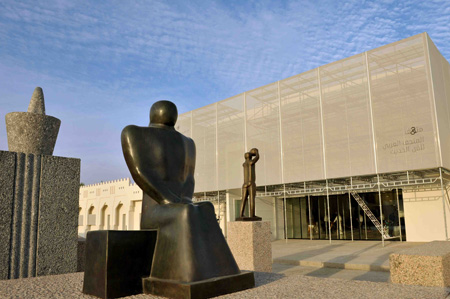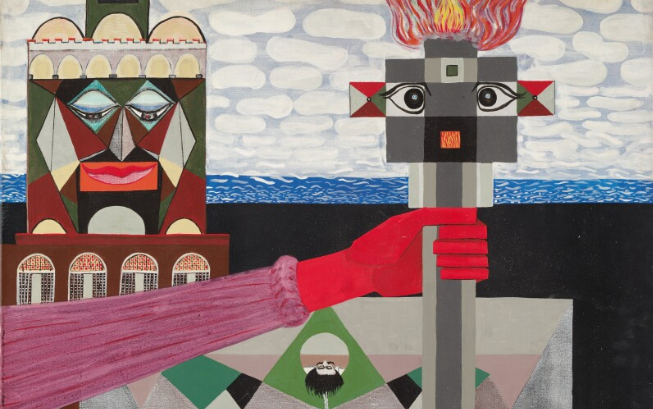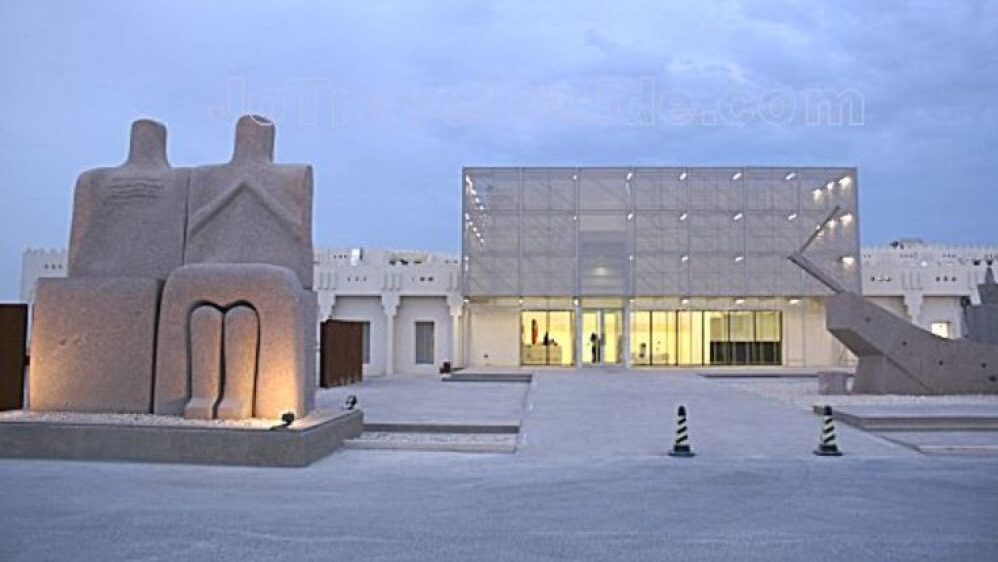As the Arab Museum of Modern Art, known lovingly as Mathaf, celebrates its 15th anniversary, the institution stands as a beacon of creativity, dialogue, and identity within the Arab world’s artistic narrative. Situated in the Education City of Doha, Mathaf has become more than just a museum; it is a living archive, a cultural landmark, and a space for questioning and redefining what modern Arab art means today. To mark this milestone, Mathaf unveils two parallel exhibitions that both trace the origins of Arab modernism and boldly confront the complexities of the present era.
This dual approach not only honors Mathaf’s legacy but also signals its evolving role as a bridge between generations of artists, scholars, and audiences who seek to understand the Arab world through its art and expression.
A Legacy Built on Vision and Cultural Commitment
When Mathaf first opened its doors in 2010, it did so with a purpose that went far beyond displaying artworks. It was founded with the intention of creating a dialogue between the Arab world’s past and its modern aspirations. The museum’s founder, Sheikh Hassan bin Mohammed bin Ali Al Thani, had spent decades collecting thousands of works by Arab artists paintings, sculptures, installations, and calligraphic pieces that together tell a story of identity, resilience, and transformation.
Over the years, Mathaf has become home to one of the largest collections of modern and contemporary Arab art in the world, housing more than 9,000 pieces. Each work in its collection contributes to an intricate mosaic of ideas, emotions, and histories, capturing the Arab world’s artistic response to colonialism, modernity, migration, and cultural revival.
Mathaf’s curatorial philosophy has always been about more than preservation. It is about participation inviting artists and audiences to think critically about the forces shaping the Arab identity in a globalized world. The museum has hosted exhibitions that confront political change, urbanization, gender narratives, and the fusion of tradition with modern forms.
The 15th Anniversary: A Celebration of Continuity and Change
To commemorate this significant milestone, Mathaf launches two landmark exhibitions, each serving as a dialogue between the historical and the contemporary. Together, they celebrate the museum’s 15-year journey while reflecting on how art continues to shape and challenge the Arab identity.
The first exhibition, Origins of Modernity, retraces the evolution of Arab modern art from the early 20th century to the present. It revisits the pioneering artists who dared to experiment beyond conventional norms—those who found inspiration in calligraphy, spirituality, and the social upheavals of their times. The second, Echoes of the Present, offers a contemporary response showcasing how today’s artists are pushing boundaries, questioning political and cultural frameworks, and experimenting with new media, installations, and digital forms.
This dual showcase demonstrates Mathaf’s central mission: to connect the roots of artistic expression with the shifting realities of the modern Arab world. The exhibitions, while distinct in their focus, share an emotional undercurrent the continuous negotiation between belonging and transformation, memory and innovation.
Revisiting the Roots: The Origins of Modernity Exhibition
The Origins of Modernity exhibition serves as a historical compass for those seeking to understand how Arab modernism took shape. It highlights works from the early and mid-20th centuries, a period marked by cultural awakening and experimentation across the Arab world.
Artists from Egypt, Iraq, Lebanon, Syria, and the Maghreb found themselves at a crossroads grappling with colonial influence while yearning to express an authentic artistic voice rooted in their heritage. These artists merged European modernist techniques with Islamic aesthetics, calligraphic abstraction, and local folklore, creating a new artistic language that was both global and deeply regional.
In this exhibition, viewers encounter seminal works that reflect an Arab modernism born not from imitation but from reinterpretation. Paintings that explore the human condition, sculptures that reinterpret ancient symbols, and experimental forms that reflect rapid urbanization all form part of this dynamic journey.
Through this retrospective, Mathaf not only honors the pioneers of modern Arab art but also contextualizes their contributions within global artistic movements, proving that Arab modernism was never peripheral it was a central force of innovation, dialogue, and vision.
Confronting the Now: Echoes of the Present
If Origins of Modernity looks backward, Echoes of the Present faces forward with boldness and urgency. This exhibition gathers contemporary artists from across the Arab world who challenge societal narratives, question identity politics, and push the limits of artistic expression.
From multimedia installations to performance art, these works explore the fragmented realities of the Arab present—themes of displacement, memory, environmental crisis, and digital transformation dominate the visual landscape. Yet amidst this complexity, there is also hope—a shared belief in the power of art to imagine better futures.
The exhibition also explores the role of technology in reshaping artistic dialogue. Young artists employ digital tools, artificial intelligence, and virtual reality to reflect on how Arab identity exists in a connected yet polarized world. Through these expressions, Mathaf becomes a platform for emerging voices, a site where innovation meets introspection.
Each installation within Echoes of the Present tells a story of confrontation and creativity. Together, they capture the essence of what Mathaf stands for today, an ever-evolving dialogue between tradition and transformation.

The Power of Place: Mathaf as a Cultural Anchor
Beyond the exhibitions, Mathaf’s very presence in Doha’s Education City is symbolic. Nestled within a hub of learning and research, it reflects Qatar’s broader vision of fostering intellectual and cultural growth. The museum’s architecture itself a fusion of modern design with Arab motifs embodies the same philosophy that guides its curatorial practice: bridging the past and the present in meaningful ways.
Over the years, Mathaf has evolved into a dynamic meeting point for artists, historians, curators, and visitors from around the world. It hosts artist talks, educational programs, residencies, and community workshops that foster engagement and exchange. The museum’s influence extends beyond Qatar, serving as a reference point for Arab art institutions globally.
In many ways, Mathaf has helped redefine how Arab art is perceived and discussed internationally. By providing context and scholarship around works that were once marginalized or misunderstood, it has opened the doors for a richer, more inclusive understanding of global modernism.
The Artists’ Voices: Personal, Political, and Poetic
What makes Mathaf’s 15th-anniversary exhibitions so compelling is the human element they bring forward. The artists featured are not just painters or sculptors they are storytellers, witnesses, and visionaries. Their works echo personal memories and collective struggles, revealing the emotional undercurrents of a region often reduced to headlines and stereotypes.
In Origins of Modernity, we see the quiet determination of early Arab artists who, in times of social change, used their creativity as resistance and reflection. In Echoes of the Present, we hear the urgency of a new generation unafraid to speak truth to power, to question the systems around them, and to demand visibility in a world still negotiating its narratives about the Arab identity.
These dual exhibitions remind us that art is never static it evolves with the times, absorbing the energies, traumas, and triumphs of each era. Mathaf’s role, therefore, is not only to exhibit but to amplify these voices, allowing them to resonate across borders and generations.
Education and Engagement: Building Bridges through Art
Since its founding, Mathaf has placed education at the heart of its mission. It has worked tirelessly to nurture young audiences, making art accessible to students, teachers, and families. Through interactive tours, workshops, and digital resources, the museum encourages people to see art not as distant history but as part of their lived experience.
One of the most remarkable aspects of Mathaf’s educational approach is how it treats art as a language one that anyone can speak, regardless of background or expertise. This inclusivity reflects Mathaf’s vision of building cultural literacy, empathy, and cross-cultural understanding.
The museum’s educational initiatives also extend beyond its walls. Collaborations with schools, universities, and international institutions help foster a global dialogue around Arab art. In doing so, Mathaf ensures that the stories of Arab artists reach new audiences, inspiring future generations to create, question, and innovate.

A Living Archive: Documenting 15 Years of Impact
Fifteen years may seem brief in the long arc of art history, yet for Mathaf, it represents a transformative journey—one that has redefined how modern Arab art is preserved and presented. Over the past decade and a half, Mathaf has not only hosted dozens of groundbreaking exhibitions but has also built a robust archive documenting artistic movements, regional trends, and personal narratives.
This archive serves as a crucial resource for scholars and researchers, offering insight into how Arab art has evolved through periods of upheaval and renewal. By documenting this history, Mathaf ensures that future generations can trace the lineage of creativity that continues to define the region.
But more than preserving the past, Mathaf’s archive embodies the spirit of continuity a belief that art’s story is ongoing, written and rewritten with every exhibition, every conversation, every work created or rediscovered.
The Future of Mathaf: Expanding Horizons
As Mathaf steps into its next chapter, it does so with renewed energy and vision. The museum aims to expand its reach, embracing new technologies, interdisciplinary collaborations, and community partnerships. Its upcoming plans include digital archiving projects, international touring exhibitions, and partnerships that promote cross-cultural dialogue between Arab and global artists.
Mathaf’s future lies in deepening its engagement not just as a museum but as a cultural ecosystem where creativity and critical thought thrive. Its commitment to sustainability, innovation, and inclusivity will guide its next decade, ensuring it remains at the forefront of artistic discourse in the Arab world.
The 15th anniversary thus marks both a celebration and a commitment to continue challenging conventions, amplifying underrepresented voices, and showcasing the transformative power of art in shaping societies.
A Celebration Beyond Walls
Ultimately, Mathaf’s 15-year celebration is not confined to galleries or exhibitions. It extends into the collective consciousness of those who have been touched by its journey artists who found their voice through its support, visitors who discovered new perspectives, and communities that continue to engage with its mission.
Mathaf’s legacy lies in the connections it fosters. Every artwork, every dialogue, every shared moment becomes part of a larger story one that belongs to the entire Arab world and resonates far beyond its borders.
As Mathaf celebrates its past and embraces its future, it stands as a testament to the enduring power of art to bridge divides, challenge perceptions, and inspire change. Fifteen years on, its journey is not just about what has been achieved but about what is yet to come.
Do follow Gulf Magazine on Instagram.
Also Read – Safeguarding Dining Excellence: Proactive Inspections at Al Wakra Municipality



